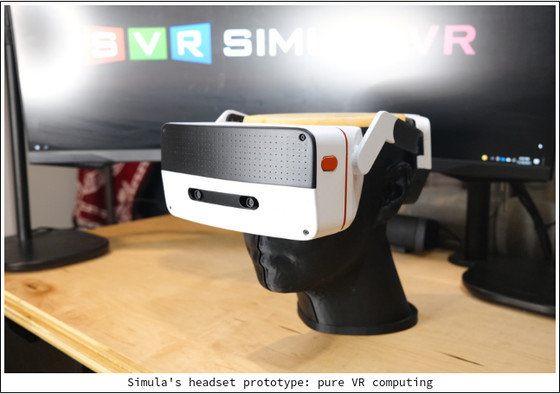Some specs of the world's first stand-alone VR headset with Linux 'Simula One' will be released

VR Comparison: Simula One vs. Valve Index vs. Quest 2 --SimulaVR
https://simulavr.com/blog/vr-comparison/
Technical overview of Simula's VR Computer --SimulaVR
https://simulavr.com/blog/technical-overview/
The Simula One looks like this.

The OS 'Simula' installed in Simula One is a Linux distribution developed for VR devices, and it is characterized by being able to execute Linux applications as they are on VR. You can understand what kind of OS Simula is by reading the following article.
Open source software 'Simula' that can display and work on the Linux desktop in VR space --GIGAZINE

Simula One is a VR device equipped with this Simula, and although it is in the prototype stage at the time of article creation, some of the specifications are released in comparison with Valve Index and Oculus Quest 2 as shown in the table below.
| Valve Index | Oculus Quest 2 | Simula One | |
| Manufacturer | Valve | Meta | SimulaVR |
| Terminal | PC connection type VR | Standalone VR | Standalone VR |
| platform | SteamVR | Oculus Home Steam VR | Linux |
| weight | 809g (Including head strap) | 503g (Including head strap) | to be decided |
| lens | Dual element fresnel lens | Fresnel lens | Triple element non-Fresnel lens |
| screen | liquid crystal | liquid crystal | liquid crystal |
| Subpixel layout | Striped RGB | Striped RGB | Striped RGB |
| resolution | One eye 1440 x 1660 pixels | One eye 1832 x 1920 pixels | One eye 2448 x 2448 pixels |
| Resolution per degree of viewing angle | 11.07 | 20.58 | 35.5 |
| Refresh rate | 144Hz | 120Hz | 90Hz |
| Adjustment range of interpupillary distance | 58 ~ 70mm hardware adjustment | 58-68 mm hardware adjustment | 55-77mm hardware adjustment |
| Pass through | 960 x 960 pixel pass-through | Grayscale pass-through with tracking camera | Full color pass-through with high-resolution wide-angle camera |
| colour | black | White & black & orange | White |
| Degree of freedom | 6DoF | 6DoF | 6DoF |
| Eye tracking | none | none | to be decided |
| Face tracking | none | none | none |
| Hand tracking | none | can be | to be decided |
| Body tracking | none | none | none |
| Built-in speaker | can be | can be | none |
| Built-in microphone | can be | can be | none |
| 3.5mm audio terminal | can be | can be | can be |
| port | USB (3.0) Type-A x 1 | USB Type-C x 1 | USB4 / Thunderbolt 4 x 1, USB Type-C (USB3.2 Gen 2) x 3-4 |
| Video connection | DisplayPort 1.2 | Oculus Link (via USB Type-C) | DisplayPort 1.4a |
| Wireless support | none | Wi-Fi 6 | Wi-Fi 6 |
| Chipset | Qualcomm Snapdragon XR2 | - | |
| CPU | none | Octa-core Kryo 585 | Intel Core i7-1165G7 |
| GPU | none | Adreno 650 | Iris Xe graphics |
| memory | none | 6GB | 16GB |
| storage | none | 128GB / 256GB | 1TB NVMe M.2 SSD |
| SD card slot | none | none | to be decided |
| Battery capacity | none | 3640mAh | to be decided |
| Continuous use time | none | About 3 hours | to be decided |
| charging time | none | About 2 hours and 30 minutes | to be decided |
| Announcement date | April 29, 2019 | September 15, 2020 | December 14, 2021 |
| Release date | April 30, 2019 | October 12, 2020 | Scheduled for January 2022 |
| price | VR kit: 138,380 yen Headset + controller: 104,280 yen | 128GB model: 37,180 yen 256GB model: 49,280 yen | to be decided |
The prototype of Simula One is based on Intel's 11th generation NUC , and the CPU is equipped with Intel Core i7-1165G7 with 4 cores and 8 threads. There is also a DisplayPort slot for connecting to an external monitor. In addition, Simula VR has a good possibility of switching to the 12th generation NUC after considering issues such as battery life.
Three lenses are stacked and the viewing angle is 100 degrees with a single eye. According to SimulaVR, Simula One also supports pass-through, which allows you to see the surrounding landscape while wearing it, and uses two high-resolution wide-angle cameras on the front to provide high-quality, full-color pass-through. It is said that AR mode will be feasible. In addition, since it has a built-in hand tracking input device 'ultralaep' developed by the manufacturer of Leap Motion, it is possible to apply the movement of the hand as it is to input. Furthermore, motion tracking is theoretically possible by using an external sensor. However, due to power and cost issues, it is unclear if it will be implemented at the time of writing the article.
Related Posts:
in Hardware, Posted by log1i_yk







